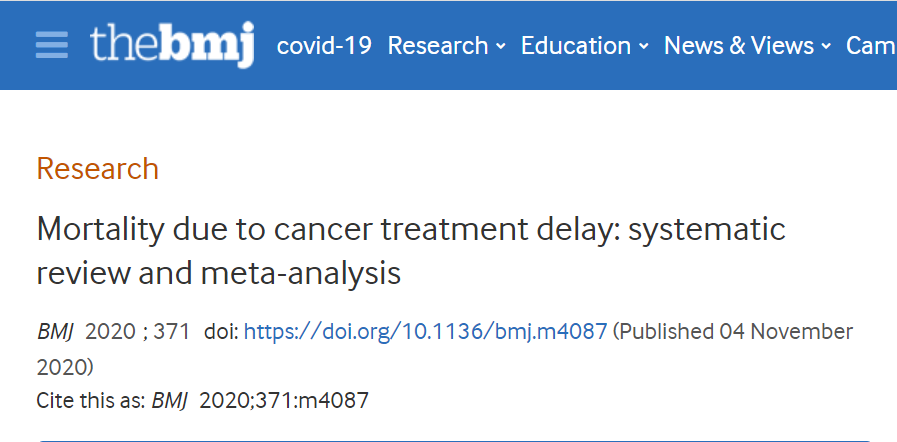In the Covid context, policies focused on minimising system level delays to cancer treatment initiation could improve population level survival outcomes.
This is an excerpt of the paper below, with the title above.
Mortality due to cancer treatment delay: systematic review and meta-analysis
The BMJ
Timothy P Hanna, associate professor123,
Will D King, associate professor3,
Stephane Thibodeau, medical resident2,
Matthew Jalink, research program manager12,
Gregory A Paulin, medical resident2,
Elizabeth Harvey-Jones, clinical oncology registrar4,
Dylan E O’Sullivan, doctoral student3,
Christopher M Booth, professor1235,
Richard Sullivan, professor6,
Ajay Aggarwal, associate professor467
Accepted 16 October 2020
Executive Summary
by Joaquim Cardoso MSc.
Chief Editor of the “Digital and Health Institute”
February 2, 2022
The context:
- Many countries have experienced deferral of elective cancer surgery and radiotherapy, and reductions in the use of systemic treatments67 because systems have reassigned healthcare resources to pandemic preparedness.8
- This analysis aims to provide robust evidence to guide national policy making, specifically the prioritisation and organisation of cancer services, by investigating the association between delays in receipt of cancer treatment and mortality.
Key messages:
- A four week delay in treatment is associated with an increase in mortality across all common forms of cancer treatment (by up to 10%), with longer delays being increasingly detrimental.
- Policies focused on minimising system level delays to cancer treatment initiation could improve population level survival outcomes.
Additional messages:
A four week delay in treatment is associated with an increase in mortality across all common forms of cancer treatment, …
- For surgery, this is a 6–8% increase in the risk of death for every four week delay.
- This impact is even more marked for some radiotherapy and systemic indications, with a 9% and 13% increased risk of death for definitive head and neck radiotherapy and adjuvant systemic treatment for colorectal cancer, respectively.
Delays of up to eight weeks and 12 weeks further increase the risk of death.
- For example, an eight week delay in breast cancer surgery would increase the risk of death by 17% (=1.088weeks/4weeks)
- and a 12 week delay would increase the risk by 26% (=1.0812weeks/4weeks).
Longer delays (eg, >20 weeks) have been associated with worse breast cancer specific survival.47 48
Such figures translate into significant population level excess mortality.
- A surgical delay of 12 weeks for all patients with breast cancer for a year (eg, during covid-19 lockdown and recovery) would lead to 1400 excess deaths in the United Kingdom, 6100 in the United States, 700 in Canada, and 500 in Australia, assuming surgery is the first treatment in 83%, and mortality without delay is 12%.10 16 49
Policies focused on minimising system level delays to cancer treatment initiation could improve population level survival outcomes.

ORIGINAL PUBLICATION
Abstract
Objective
To quantify the association of cancer treatment delay and mortality for each four week increase in delay to inform cancer treatment pathways.
Design
Systematic review and meta-analysis.
Data sources
Published studies in Medline from 1 January 2000 to 10 April 2020.
Eligibility criteria for selecting studies
Curative, neoadjuvant, and adjuvant indications for surgery, systemic treatment, or radiotherapy for cancers of the bladder, breast, colon, rectum, lung, cervix, and head and neck were included.
The main outcome measure was the hazard ratio for overall survival for each four week delay for each indication.
Delay was measured from diagnosis to first treatment, or from the completion of one treatment to the start of the next.
The primary analysis only included high validity studies controlling for major prognostic factors. Hazard ratios were assumed to be log linear in relation to overall survival and were converted to an effect for each four week delay. Pooled effects were estimated using DerSimonian and Laird random effect models.
Results
The review included 34 studies for 17 indications (n=1 272 681 patients).
No high validity data were found for five of the radiotherapy indications or for cervical cancer surgery.
The association between delay and increased mortality was significant (P<0.05) for 13 of 17 indications.
Surgery findings were consistent, with a mortality risk for each four week delay of 1.06–1.08 (eg, colectomy 1.06, 95% confidence interval 1.01 to 1.12; breast surgery 1.08, 1.03 to 1.13).
Estimates for systemic treatment varied (hazard ratio range 1.01–1.28).
Radiotherapy estimates were for
- radical radiotherapy for head and neck cancer (hazard ratio 1.09, 95% confidence interval 1.05 to 1.14),
- adjuvant radiotherapy after breast conserving surgery (0.98, 0.88 to 1.09), and
- cervix cancer adjuvant radiotherapy (1.23, 1.00 to 1.50).
A sensitivity analysis of studies that had been excluded because of lack of information on comorbidities or functional status did not change the findings.
Conclusions
Cancer treatment delay is a problem in health systems worldwide.
The impact of delay on mortality can now be quantified for prioritisation and modelling.
Even a four week delay of cancer treatment is associated with increased mortality across surgical, systemic treatment, and radiotherapy indications for seven cancers.
Policies focused on minimising system level delays to cancer treatment initiation could improve population level survival outcomes.
BOX 1
What is already known on this topic
- Delay in the treatment of cancer can have adverse consequences on outcome
- Previous meta-analyses of high validity studies have found evidence supporting a continuous relation between delay and mortality or local control
- Despite its foundational importance, we lack standardised estimates of the effect of treatment delay for most treatment indications
What this study adds
- This systematic review considered seven major cancer types (bladder, breast, colon, rectum, lung, cervix, and head and neck) and three treatment modalities (surgery, systemic treatment, and radiotherapy)
- The data consistently show that a four week treatment delay is associated with increased mortality; further mortality was reported with longer delays
- Policies focused on minimising system level delays in cancer treatment initiation could improve population level survival outcomes
LONG VERSION

Mortality due to cancer treatment delay: systematic review and meta-analysis
The BMJ
Timothy P Hanna, associate professor123,
Will D King, associate professor3,
Stephane Thibodeau, medical resident2,
Matthew Jalink, research program manager12,
Gregory A Paulin, medical resident2,
Elizabeth Harvey-Jones, clinical oncology registrar4,
Dylan E O’Sullivan, doctoral student3,
Christopher M Booth, professor1235,
Richard Sullivan, professor6,
Ajay Aggarwal, associate professor467
Accepted 16 October 2020
This is an excerpt from the full version of the publication.
Introduction
Delay in the treatment of cancer can have adverse consequences on outcome.
However, despite its foundational importance, we lack standardised estimates of the effect of treatment delay on survival for most treatment indications. Previous meta-analyses have found evidence supporting a continuous association between delay and mortality12 or local control.3 A wide variation in reporting of delay estimates has limited meta-analysis.4
Understanding the impact of delay on mortality and other outcomes such as recurrence or financial impact on patients is essential to designing cancer care systems, pathways, and models of care that deliver affordable and equitable outcomes.5
The need for an in-depth understanding of the impact of treatment delay on outcomes has come sharply into focus during the coronavirus 2019 (covid-19) pandemic.
Many countries have experienced deferral of elective cancer surgery and radiotherapy, and reductions in the use of systemic treatments67 because systems have reassigned healthcare resources to pandemic preparedness.8
The lack of high quality data on the impact of deferred and delayed cancer treatment has meant that the impact of covid-19 lockdown measures on patterns of care and subsequent outcomes has not been robustly quantified.
More broadly, in non-pandemic times, health systems have developed pathways and targets for intervals from the time of diagnosis to receipt of treatment within National Cancer Control Plan frameworks that do not have a strong empirical basis.9
Our analysis aims to provide robust evidence to guide national policy making, specifically the prioritisation and organisation of cancer services, by investigating the association between delays in receipt of cancer treatment and mortality.
We considered seven common cancers and provide estimates on the impact of delay across all three curative modalities: surgery, systemic treatment, and radiotherapy delivered in the radical, neoadjuvant, and adjuvant setting.
Methods
See the original publication
Results
See the original publication

Discussion
Principal findings
This analysis reports the impact of delay in curative treatment on the risk of death across the seven major tumour types: bladder, breast, colon, rectum, lung, cervix, and head and neck, and across all three major treatment modalities (surgery, systemic treatment, and radiotherapy).
Across all three modalities, we found that a treatment delay of four weeks is associated with an increase in the risk of death.
- For surgery, this is a 6–8% increase in the risk of death for every four week delay.
- This impact is even more marked for some radiotherapy and systemic indications, with a 9% and 13% increased risk of death for definitive head and neck radiotherapy and adjuvant systemic treatment for colorectal cancer, respectively.
- The one high validity study for breast cancer adjuvant radiotherapy did not show an effect, although a clear effect of delay on local control has been described (hazard ratio for each month of delay 1.08, 95% confidence interval 1.02 to 1.14);
- longer delays (eg, >20 weeks) have been associated with worse breast cancer specific survival.47 48
Policy implications and comparison to other studies
Our analysis builds on the foundations of Mackillop and colleagues, who investigated the mortality impact per one month delay for radiotherapy indications (eg, head and neck, breast) and similarly for systemic treatment (adjuvant colon, breast).12347
Our study provides a strong empirical basis for estimating the mortality impact of system level delays for different treatment modalities and cancers.
Delays of up to eight weeks and 12 weeks further increase the risk of death.
- For example, an eight week delay in breast cancer surgery would increase the risk of death by 17% (=1.088weeks/4weeks)
- and a 12 week delay would increase the risk by 26% (=1.0812weeks/4weeks).
Such figures translate into significant population level excess mortality.
- A surgical delay of 12 weeks for all patients with breast cancer for a year (eg, during covid-19 lockdown and recovery) would lead to 1400 excess deaths in the United Kingdom, 6100 in the United States, 700 in Canada, and 500 in Australia, assuming surgery is the first treatment in 83%, and mortality without delay is 12%.10 16 49
- These results are sobering and suggest that the survival gained by minimising the time to initiation of treatment is of similar (and perhaps greater) magnitude of benefit as that seen with some novel therapeutic agents.50
- Furthermore, our results do not consider the impact of treatment delay on local control rates, functional outcomes (eg, continence, swallowing), complications from more extensive treatments because of progression during delays, quality of life,51 or the greater economic burden because of higher direct care costs and productivity losses because of premature mortality and morbidity.52
- Therefore, the impact of treatment delay is probably far greater for patients and society than that reflected in our results.
Treatment delays could be due to
- patient factors (eg, need for cardiac workup, postoperative wound infection),
- disease factors (eg, need for additional imaging investigations), or
- system factors (eg, waiting for an operating room date, a central line insertion, or a specialist consultation).
The main purpose of this discussion is to highlight the need to minimise system level delays.
We strongly emphasise that patients should not start surgery, systemic treatment, or radiotherapy until they are medically fit to do so, and have completed appropriate investigations.
- We also acknowledge that for rectal cancer, for instance, an increasing body of evidence shows that deferral of surgery after radiotherapy might not confer a survival disadvantage for those having a complete response.53
A major finding from our study is the paucity of high quality data for several tumour specific indications for radiotherapy, including chemoradiation for non-small cell lung cancer and definitive cervical cancer treatment.
Two high validity studies providing delay estimates across multiple treatment modalities for these tumour types suggest an impact of delay in treatment initiation in these settings (cervical cancer mortality for each four week delay:
hazard ratio 1.04, 95% confidence interval 1.02 to 1.0754; stage III non-small cell cancer: 1.03, 1.01 to 1.06).55
While the negative impact of treatment interruptions on survival outcomes is well documented for these tumours,565758 evidence is insufficient about the exact impact of a delay in starting treatment, which given its importance, should be an urgent research priority.
The study results are timely in light of the current covid-19 pandemic.
Internationally, some countries have released national guidance on prioritisation of surgical treatments for cancer, which do not appear to be supported by the results of this study.
For example, at the beginning of the pandemic the UK NHS 59 created a short term surgical prioritisation algorithm.
Several indications were considered safe to be delayed by 10–12 weeks with no predicted impact on outcome, including all colorectal surgery.
Therefore, our results can help to directly inform policy — we found that increasing the wait to surgery from six weeks to 12 weeks would increase the risk of death in this setting by 9%.
We note that a delay of less than four weeks should not be justified as safe based on our findings.
- For example, our results suggest a 4% increased risk of death for a two week delay for breast cancer surgery (1.082weeks/4weeks; appendix 2).
Taken as a whole, these results suggest there is an urgent need to reconsider how we organise our cancer services.
The prevailing paradigm has been around access to new treatments to improve outcomes, but from a system level, gains in survival might be achieved by prioritising efforts to minimise the time from cancer diagnosis to initiation of treatment from weeks to days.
We acknowledge that treatment delays are multifactorial in cause and that patients should not start treatment before they are medically fit to do so, and have had completed all appropriate evaluations, however these data strongly support efforts to minimise system level delays.
For example, national quality indicators around cancer waiting times from diagnosis to treatment are widely used across different health systems.
In the UK NHS, current targets for the initiation of primary definitive treatment have been set at 31 days from the decision to treat date; this does not include the lag between receiving a diagnosis and having a surgical or radiation oncology consultation for treatment.9 60
At a population level, differences in lead times to treatment of even two or three weeks could be a factor in why survival outcomes differ across health systems and needs further investigation.
However, these delays need to be balanced with the necessity to be medically fit for treatment.
Additionally, potential opportunities for second opinions could result in more effective or appropriate care, especially where variation in practice or outcomes exist across providers.
Options for decreasing delay after diagnosis include
- increasing specialist workforce capacity through training initiatives
- or overcoming these challenges through technological developments.
- For example, automated treatment contouring and planning is increasingly standardised and reduces the radiotherapy preparation time to hours rather than days.61
- Satellite centres might improve capacity for treating patients,
- as can reconfiguration of existing infrastructure to high volume super specialised services,
- or single entry models and team based care.62
- Innovations in surgical technique could also minimise morbidity and reduce time to adjuvant therapy.63 64
Options for decreasing delay after diagnosis include
(1) increasing specialist workforce capacity through training initiatives
(2) or overcoming these challenges through technological developments.
Strengths and limitations of this study
Our study provides evidence on the association of treatment delay and mortality, covering seven cancer types and three treatment modalities.
Our study was based on observational data, and we therefore restricted our sample to high validity studies given the biases inherent to this study design.
Our approach provides high level evidence on system delay because randomised trials in this context are not appropriate or feasible.
The most fundamental limitation of our study is the risk of residual confounding. Patients with longer treatment delays could be destined to have inferior outcomes for reasons of comorbidity, treatment morbidity, or performance status. In evaluating the validity of our findings, we note the coherence of overall mortality and cancer specific endpoints (local control, cancer specific survival, disease-free survival) for all past meta-analyses of high validity studies.12347
We also note major detrimental effects of prolonged waiting times on cancer specific survival outcomes in 13 of 15 studies included in our meta-analysis that reported cancer survival outcomes alongside overall survival.141622282930313233343536383946
These studies span seven treatment indications. Factors associated with medical status such as elements of socioeconomic status or insurance status might also be confounding factors; we found that 91% and 82% of identified studies accounted for these, respectively, though this does not completely rule out the possibility of residual confounding.
Twenty five of 34 identified studies were from the USA, though no significant heterogeneity was detected compared with other countries.
Our findings cannot be directly applied to other cancer specific treatment indications, or to subgroups or single patients with treatment indications considered here.
For example, limited evidence suggests that the impact of delay can vary according to stage, often with consistently greater mortality impact with earlier stage disease.1617182555
Additionally, our results can only be applied to the range of delay considered in the studies we evaluated.
Given evidence derived from cancers representing almost half of all patients, the precautionary principle (acting to avoid or diminish harm in the face of scientific uncertainty) should be used when determining acceptable waiting times for treatment where data are limited.8
Too few studies were found for most indications to perform a risk of publication bias assessment with funnel plots.
For previous meta-analyses where enough studies existed to do so, findings were not explained by publication bias.12
We acknowledge that the assumption of a log linear relation between waiting time and mortality could be an oversimplification.
This assumption was required to estimate per unit time mortality impact of delay from studies that use a variety of wait time representations. However, there is support for this assumption in the primary studies we used. A continuous exposure from nine primary studies assumed (log) linearity. Six studies undertook cubic spline analysis and the results are compatible with log linear effects with the range of wait times considered here (four weeks to 16 weeks).151921264145 Moreover, the previous meta-analyses by Biagi and colleagues and Raphael and colleagues suggest a reasonable fit of a log linear relation to delay.12 If a linear relation with delay exists (rather than log linear), the degree of difference in the two models is expected to be sufficiently small to allow use of a log linear model for the specific purposes of modelling the impact of delay on mortality between four and 16 weeks (appendix 2). We emphasise that assuming log linearity outside of the range of wait times used in this analysis is inappropriate. Our findings should also not be used to evaluate whether there is a minimal safe delay, or to estimate the impact of delay beyond 16 weeks.
Our results reflect the impact of delay on large and expectedly heterogeneous populations with varying risks of recurrence.
Therefore, these estimates are best used at a policy and planning level for modelling, rather than for individual risk prediction. We also emphasise that few studies considered the impact of immortal time bias on delay; this could be done through a landmark analysis for survival.
Patients that survived a longer wait might have less aggressive tumours, biasing the delay effect towards the null. Our findings could therefore underestimate the impact of delay on mortality.
Conclusions
A four week delay in treatment is associated with an increase in mortality across all common forms of cancer treatment, with longer delays being increasingly detrimental.
In light of these results, policies focused on minimising system level delays in cancer treatment initiation could improve population level survival outcomes.
Appendix
Figure 2

Figure 3


Figure 4

About the authors & affiliations
Timothy P Hanna, associate professor123,
Will D King, associate professor3,
Stephane Thibodeau, medical resident2,
Matthew Jalink, research program manager12,
Gregory A Paulin, medical resident2,
Elizabeth Harvey-Jones, clinical oncology registrar4,
Dylan E O’Sullivan, doctoral student3,
Christopher M Booth, professor1235,
Richard Sullivan, professor6,
Ajay Aggarwal, associate professor467
- Division of Cancer Care and Epidemiology, Cancer Research Institute at Queen’s University, 10 Stuart Street, 2nd Level, Kingston, ON K7L3N6, Canada
- Department of Oncology, Queen’s University, Kingston, ON, Canada
- Department of Public Health Sciences, Queen’s University, Kingston, ON, Canada
- Department of Clinical Oncology, Guy’s & St Thomas’ NHS Trust, London, UK
- Department of Medicine, Queen’s University, Kingston, ON, Canada
- Institute of Cancer Policy, King’s College London, London, UK
- Department of Health Services Research and Policy, London School of Hygiene and Tropical Medicine, London, UK
Originally published at https://www.bmj.com












